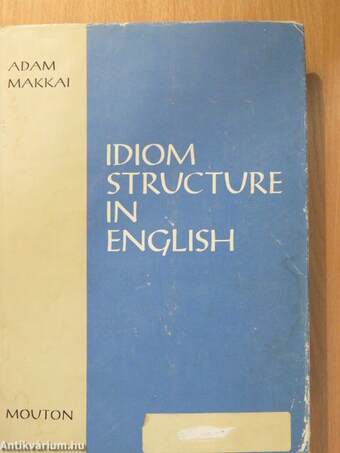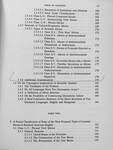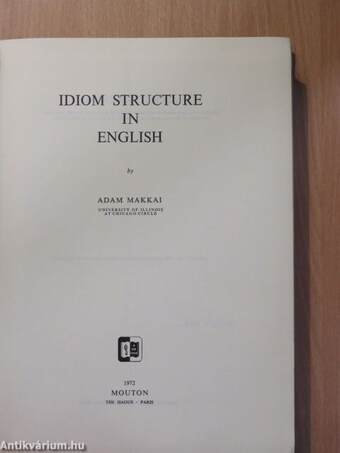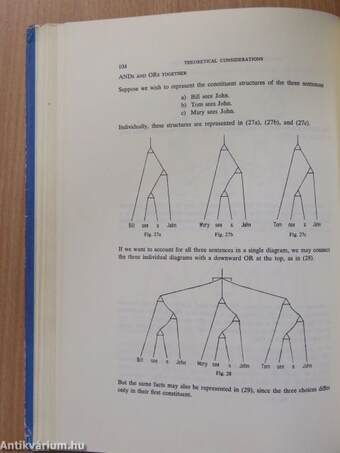1.066.481
kiadvánnyal nyújtjuk Magyarország legnagyobb antikvár könyv-kínálatát

VISSZA
A TETEJÉRE
JAVASLATOKÉszre-
vételek
Idiom Structure in English
| Kiadó: | Mouton & Co. N. V., Publishers |
|---|---|
| Kiadás helye: | Hága |
| Kiadás éve: | |
| Kötés típusa: | Fűzött keménykötés |
| Oldalszám: | 371 oldal |
| Sorozatcím: | |
| Kötetszám: | |
| Nyelv: | Angol |
| Méret: | 27 cm x 19 cm |
| ISBN: | |
| Megjegyzés: | Első kiadás! Fekete-fehér ábrákkal és egy kihajtható melléklettel. |
naponta értesítjük a beérkező friss
kiadványokról
naponta értesítjük a beérkező friss
kiadványokról
Fülszöveg
The neglected study of idioms has taken on new dimensions and special interest in the wake of the recent theoretical revolution in linguistics, starting in 1957 with Chomsky's transformational-generative grammar, followed and gradually supplanted by generative semantics, case-grammar, and stratificational grammar of various types. It is in fact possiblef to outline the evolution of linguistics in this century as structural-generative-cognitive where each successive new stage became possible only by building on the results of the previous school of thought. Thus the once strongly discouraged study of meaning came strongly into the foreground during the more mature phases of transformational-generative grammar and, in fact, paved the road to the eventual transformation of generativism into cognitive inquiry. Tagmemics, the most mature brand of item-and-arrangement grammars, was the only brand of structuralism seriously to encompass meaning, culture, and units beyond the sentence.... TovábbFülszöveg
The neglected study of idioms has taken on new dimensions and special interest in the wake of the recent theoretical revolution in linguistics, starting in 1957 with Chomsky's transformational-generative grammar, followed and gradually supplanted by generative semantics, case-grammar, and stratificational grammar of various types. It is in fact possiblef to outline the evolution of linguistics in this century as structural-generative-cognitive where each successive new stage became possible only by building on the results of the previous school of thought. Thus the once strongly discouraged study of meaning came strongly into the foreground during the more mature phases of transformational-generative grammar and, in fact, paved the road to the eventual transformation of generativism into cognitive inquiry. Tagmemics, the most mature brand of item-and-arrangement grammars, was the only brand of structuralism seriously to encompass meaning, culture, and units beyond the sentence. Stratificational grammar adds to these previous schools of thought by presenting a detailed theory of the four central strata of natural languages, the sememic, lexemic, morphemic, and phonemic, with the relevant units relationships and tactics of each stratum. The idiom, by its very nature, is a linguistic phenomenon which cannot be fully understood without a stratificational view of language. Unitary in meaning, unpredictable as to syntax, and complex, hence misleading in expression, the idiom either belongs in the lexemic system (if it is identifiable with a form class) or in the sememic and/or hypersememic system, if it is of independent clause size, or the proverbial expression of a morál or maxim. The present study, for the first time, presents such a coherent picture of the idiom structure of English with ample illustrations and definitions at each step. Before presenting the idiom structure of English in stratificational terms, however, the book gives a detailed survey of all known approaches to idiomaticity in order objectively to illustrate why the author finds the stratificational system more suitable than all others combined to deal with idiomaticity. Considered merely as a pilot study to a forthcoming larger work, Idiom Structure in English does not attempt to give a full dictionary of English idioms. The most carefully documented type of idiom in this book is the elusive and recalcitrant phrasal verb, whose partial description occupies the major portion of Part 2. It is in this particular section that the book makes its most objectively verifiable contribution by presenting statistical evidence concerning the literal origin of phrasal verb idioms in terms of Kronasser's Law of semantic charge from the concrete toward the abstract, Pierson r correlations, and x* tests of significance. VisszaTémakörök
Adam Makkai
Adam Makkai műveinek az Antikvarium.hu-n kapható vagy előjegyezhető listáját itt tekintheti meg: Adam Makkai könyvek, művekMegvásárolható példányok
Nincs megvásárolható példány
A könyv összes megrendelhető példánya elfogyott. Ha kívánja, előjegyezheti a könyvet, és amint a könyv egy újabb példánya elérhető lesz, értesítjük.














